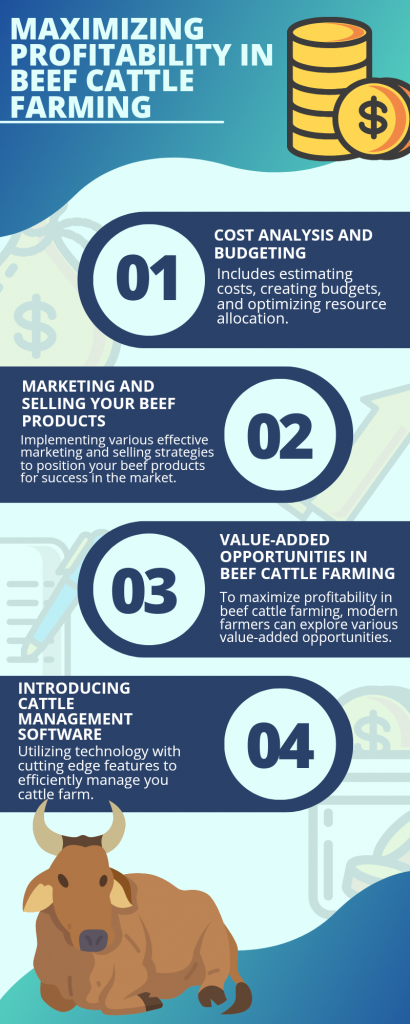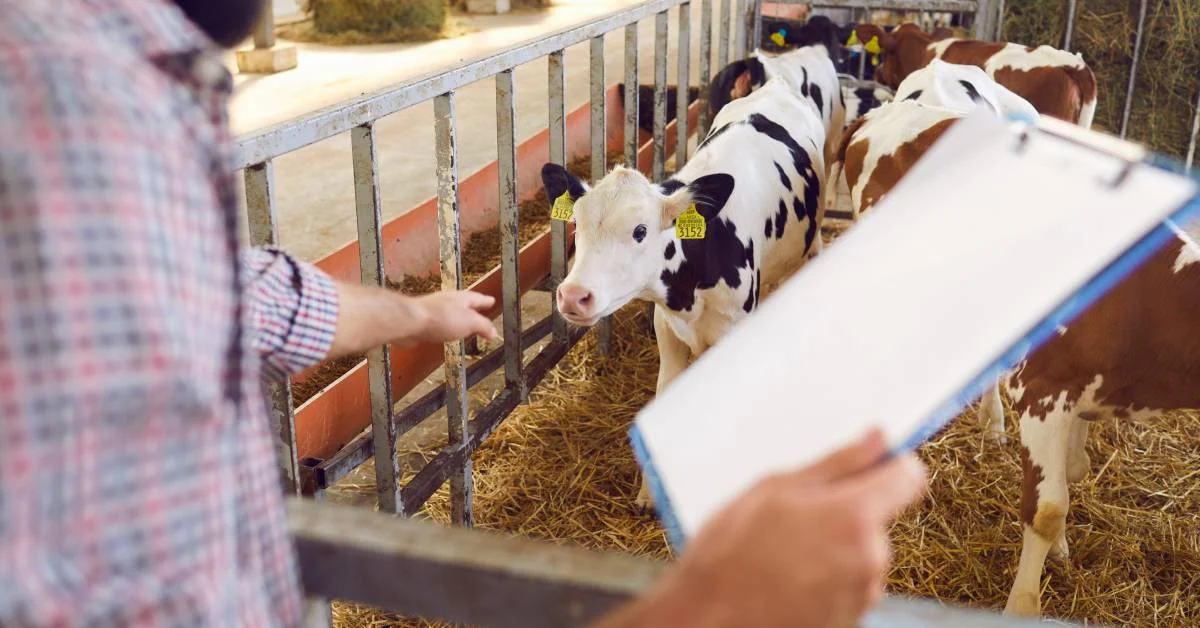Welcome to the captivating world of beef cattle farming! In a time where cattle farming practices and agricultural self-sufficiency are increasingly vital, the art of raising healthy beef cattle has become a cornerstone skill for modern farmers like yourself. Whether you’re a seasoned rancher seeking to refine your techniques or a budding farmer eager to embark on this fulfilling venture, having access to a comprehensive guide is an absolute must.
Section 1: Getting Started with Raising Beef Cattle

Overview of Raising Beef Cattle
Raising healthy beef cattle plays a pivotal role in the agriculture industry, offering numerous benefits for modern farmers who understand the importance of modern beef farming techniques. This comprehensive guide aims to provide you with a solid foundation for raising beef cattle for profit, highlighting its significance in sustainable beef cattle farming agriculture and profitability covering beef cattle herd management, beef cattle breeding, its nutrition, beef cattle marketing, and more.
How to Choose the Right Cattle Breed?
Selecting the appropriate cattle breed is a crucial decision that can significantly impact the success of beef cattle breeding, and your beef cattle farming venture. As a modern farmer, it is essential to consider several factors when making this choice, including temperament, adaptability, and market demand.
Different cattle breeds have varying levels of tolerance to specific climates, landscapes, and disease resistance. Assess the environmental conditions of your region and select a breed that thrives in those conditions, ensuring the health and well-being of your cattle.
Market demand and technology in beef farming are critical factors in determining the profitability of your beef cattle farming enterprise. Research the market trends and preferences to identify breeds that are in high demand. Factors such as meat quality, taste, and consumer preferences can influence market demand. By aligning your breed selection with market demand, you can position yourself for success and maximize your returns through beef cattle marketing.
Selecting Quality Calves for Raising
Raising beef cattle for profit calls for crucial attention to detail; selecting quality calves is a crucial step that sets the foundation for a successful and sustainable operation. Assessing calf health, genetics, and conformation are key factors to consider in beef cattle farming.
- Assess Calf Health:
The health of the calf plays a vital role in its growth and development. It’s also important to inquire about the calf’s vaccination history and any previous health issues for successful beef cattle herd management.
- Evaluate Genetics:
Genetics greatly influence the potential of a calf in terms of growth rate, meat quality, and disease resistance. Research the lineage of the calves you’re considering and look for reputable breeders known for producing high-quality stock. Consider the breed characteristics that align with your farming goals.
- Consider Conformation:
Conformation refers to the physical structure and body composition of the calf. A calf with good conformation is more likely to have efficient feed conversion, better mobility, and improved market value.
- Seek Professional Assistance:
If you’re new to raising beef cattle or feel uncertain about evaluating calves on your own, consider seeking guidance from experienced farmers, breeders, or veterinarians for their valuable insight.
- Utilize Data and Technology in Beef Farming:
Modern beef farming techniques leverage technology to enhance the selection process. Consider using cattle management software that tracks important data such as birth weights, growth rates, and genetic information.
Setting Up Proper Infrastructure and Facilities
When it comes to raising beef cattle for profit, setting up the right infrastructure and facilities is crucial for the success of your operation. A well-designed cattle farm not only ensures the safety and well-being of the animals but also enhances efficiency in management and maximizes productivity.
- Housing:
A sturdy and spacious barn or shelter is necessary to protect the animals from extreme weather conditions such as heat, cold, wind, and rain for the animals to be comfortable and safe, and for better beef cattle herd management.
- Fencing:
A secure and well-maintained fencing system is essential for the safety and containment of your beef cattle. Fences should be durable and designed to withstand the strength and size of the animals.
- Feeding Equipment:
To efficiently manage beef cattle nutrition, invest in appropriate feeding equipment. Feeders, troughs, bunks, and automated feeding systems ensure that the cattle receive the right amount of feed at the right time.
Farmers must prioritize beef cattle record-keeping and beef cattle herd management. Utilizing cattle management software can greatly simplify the process of tracking individual animal data, such as breeding history, health records, and weight gain.
Section 2: Best Practices for Raising Healthy Beef Cattle
Proper Nutrition and Feeding Guidelines
Proper nutrition plays a vital role in the health and growth of beef cattle. Understanding the beef cattle nutrition requirements at different stages is crucial for raising healthy and productive animals.
Nutritional Requirements of Beef Cattle at Different Stages
Beef cattle have distinct nutritional needs during various stages of their lives. It is essential to provide them with a balanced diet that meets these requirements to ensure optimal growth and development.
- Calves:
During the early stages of life, raising healthy beef cattle requires a diet rich in energy, protein, vitamins, and minerals to support rapid growth for the calves. High-quality milk or milk replacers should be provided, along with access to clean water and starter feeds to encourage early rumen development.
- Growing Cattle:
As cattle transition from calves to growing animals, their nutritional needs evolve. A combination of pasture grazing, high-quality forage, and balanced concentrate feeds is typically recommended.
- Breeding Cattle:
Proper nutrition is crucial for reproductive success in beef cattle breeding. Providing a well-balanced diet is essential to ensure successful beef cattle breeding.
Feeding Strategies for Beef Cattle
- Grazing:
Pasture grazing is an integral part of beef cattle farming. Rotational grazing systems can help optimize pasture utilization and prevent overgrazing. It is important to ensure that pastures are adequately managed, with proper fertilization and regular monitoring of forage quality.
- Supplementary Feeding:
Supplementary feeding is often necessary to meet the nutritional requirements of beef cattle. This can involve providing high-quality hay, silage, or grain-based concentrate feeds.
- Record-keeping for Beef Cattle Nutrition
Maintaining accurate records of beef cattle nutrition is essential for effective management and monitoring. Modern beef farming techniques utilize software systems and technology. In beef farming, specifically designed cattle management software tracks feed formulations, monitors individual animal performance, and provides insights.
Cattle Health Management and Vaccination Protocols
When it comes to raising beef cattle, ensuring the health and well-being of your animals is crucial for a successful and profitable operation. Implementing proper cattle farming practices is essential to safeguarding your herd against diseases and maintaining their overall productivity.
- Preventive Healthcare Measures
Preventive healthcare, such as record-keeping, vaccination, and other measures, plays a vital role in minimizing the risk of diseases among your beef cattle.
- Vaccination Schedules
Establishing a vaccination schedule ensures that your cattle receive the necessary immunizations at the appropriate times. Common vaccinations for beef cattle include those for respiratory diseases like bovine respiratory syncytial virus (BRSV), etc.
- Routine Health Checks
Regular health checks are essential for early detection of any potential health issues in your beef cattle. These provide an opportunity to assess overall herd health, identify individual animals in need of special attention, and ensure that your herd is meeting its nutritional requirements.
Managing Parasites and Diseases
Parasite Prevention in Beef Cattle
Effective parasite prevention is crucial for maintaining a healthy beef cattle herd.
- Rotational Grazing:
Implement rotational grazing to limit exposure to parasites and allow pastures to rest and parasites to die off.
- Fecal Testing and Deworming:
Regularly test fecal samples to identify parasites and develop tailored deworming protocols with the guidance of a veterinarian.
- Strategic Grazing and Herd Separation:
To reduce parasite spread, separate young and susceptible animals from older, immune animals. Alternate pastures between cattle and other livestock species.
- Adequate Nutrition:
To boost cattle’s immune systems, provide a balanced diet with high-quality forage, clean water, and proper mineral supplementation.
Disease Management in Beef Cattle
Managing diseases is vital for the well-being of beef cattle.
- Vaccination Programs:
Develop a customized vaccination program with a veterinarian to protect against prevalent diseases in your region.
- Biosecurity Measures:
Implement strict biosecurity protocols, such as quarantining new animals and maintaining proper sanitation, to prevent disease introduction and spread.
- Regular Health Checks and Beef Cattle Record-Keeping:
Conduct routine health checks to identify early signs of illness and maintain detailed records of herd health to facilitate timely interventions and support future prevention strategies.
Implementing Effective Breeding Strategies
Breeding plays a crucial role in raising healthy beef cattle. Modern farmers have access to a variety of breeding techniques and genetic selection methods.
- Artificial Insemination:
Artificial insemination (AI) is a widely used technique in modern beef farming. It involves collecting semen from a high-quality bull and introducing it into the reproductive tract of a female cow. AI offers several advantages, including the ability to use superior genetics from distant locations.
- Natural Breeding:
Allowing bulls to naturally breed with cows promotes genetic diversity and ensures natural selection. It is essential to maintain a healthy ratio of bulls to cows and monitor breeding behavior and overall health of the bulls.
- Genetic Selection:
Genetic selection is a powerful tool for improving the traits and overall productivity of beef cattle. Modern farmers have access to various genetic evaluation tools and performance records that help in identifying animals with desirable traits such as growth rate, feed efficiency, and carcass quality.
Optimizing Pasture and Grazing Management
Implementing effective strategies for pasture rotation, forage selection, and pasture improvement ensures that the cattle maintain optimal health when it comes to raising healthy beef cattle.
- Pasture Rotation:
Implementing a pasture rotation system is essential for maintaining healthy pastures and maximizing forage utilization. Rotating cattle to fresh pastures allows the land to recover, prevents overgrazing, and reduces the risk of diseases and parasites.
- Forage Selection:
The choice of forage plays a significant role in the health and productivity of beef cattle. It is important to select a diverse range of forage species that suit your region’s climate and soil conditions.
- Pasture Improvement:
Regular pasture improvement practices contribute to healthier grazing lands. Implement techniques such as overseeding, fertilization, and weed control to enhance the quality and productivity of your pastures. Conduct soil testing to determine nutrient deficiencies and adjust fertilization accordingly.
- Water Availability:
Access to clean and plentiful water is essential for cattle health and performance. Ensure that water sources are strategically located throughout the pasture to facilitate easy access for all animals, maintain cleanliness, and repair promptly when required.
Section 3: Maximizing Profitability in Sustainable Beef Cattle Farming

Cost Analysis and Budgeting for Raising Beef Cattle
Estimating costs, creating budgets, and optimizing resource allocation are essential for maximizing profitability in beef cattle farming.
Estimating Costs
- Initial investment:
Consider purchasing or breeding cattle, acquiring land, and constructing infrastructure.
- Feed and nutrition:
Calculate costs for high-quality feed, forage, supplements, and minerals.
- Veterinary care:
Account for vaccinations, deworming, and emergency medical expenses.
- Labour and personnel:
Include wages or salaries for farm employees and veterinary professionals.
- Marketing and sales:
Budget for advertising, transportation, and participation in auctions or shows.
- Overhead expenses:
Account for utilities, insurance, property taxes, and miscellaneous costs.
Creating Budgets
- Revenue projections:
Determine expected income from selling beef cattle and related products.
- Operating expenses:
Allocate funds for feed, veterinary care, labour, marketing, and utilities.
- Contingency fund:
Set aside a portion of the budget for unexpected expenses.
- Capital investments:
Plan for future infrastructure and equipment upgrades.
Profit margin:
Aim for a reasonable margin by balancing income and expenses.
Optimizing Resource Allocation
- Feed management:
Optimize feed programs with cost-effective and nutritionally balanced options.
- Herd management:
Maintain accurate records and use modern cattle management tools.
- Health management:
Implement preventive measures and develop a herd health plan.
- Marketing strategies:
Enhance visibility and value through direct sales and effective marketing.
Marketing and Selling Your Beef Products
When it comes to raising beef cattle for profit, effective marketing and selling strategies play a crucial role in maximizing your profitability.
- Exploring Different Marketing Channels
Exploring various marketing channels is essential to reaching a wider customer base and increasing the chances of selling your beef products.
- Local Farmers’ Markets:
Participating in local farmers’ markets allows you to directly engage with consumers who value locally sourced, high-quality meat.
- Restaurants and Specialty Stores:
Collaborating with restaurants and specialty stores that focus on sourcing premium meat can be a profitable avenue for selling your beef products.
- Online Platforms:
Utilize online platforms, such as e-commerce websites and social media, to showcase your beef products to a broader audience.
- Direct-to-Consumer Sales
Cutting out the middleman by selling your beef products directly to consumers can significantly impact your profitability.
- Farm Stores or On-Farm Sales:
Establish a farm store where customers can visit and purchase your beef products.
- Community-Supported Agriculture (CSA):
Implement a CSA program where customers can subscribe to receive regular deliveries of your beef products.
- Custom Meat Orders:
Offer custom meat orders, allowing customers to request specific cuts and quantities.
- Implementing Branding Strategies
Developing a strong brand for your beef products can differentiate them from competitors and attract loyal customers.
- Quality Assurance:
Emphasize the high quality and superior taste of your beef products.
- Storytelling:
Share your farm’s story and the values that drive your beef cattle farming operation.
- Packaging and Labeling:
Invest in appealing and informative packaging and labels that communicate your brand identity.
Value-Added Opportunities in Beef Cattle Farming
To maximize profitability in sustainable beef cattle farming, modern farmers can explore various value-added opportunities.
- Organic Certification
Organic certification allows farmers to tap into the growing market of health-conscious consumers seeking organic beef. Organic certification ensures compliance with strict standards, enabling farmers to command premium prices for their organic products.
- Direct-to-Restaurant Partnerships
Establishing direct-to-restaurant partnerships allows farmers to connect directly with chefs and restaurants looking for locally sourced, sustainably raised beef.
- Farm-to-Table Programs
Participating in farm-to-table programs provides farmers with an opportunity to directly market their beef products to consumers showcasing sustainable beef cattle farming.
- Embracing Technology
Modern beef farming techniques leverage technology to improve efficiency and profitability. Farmers can invest in cattle management software, which helps track important data such as breeding records, health information, and feed management.
Leveraging Technology: Introducing Cattle Management Software
- Streamline Operations with Advanced Software Solutions
Efficient record-keeping, seamless integration, and improved productivity are within reach with our cutting-edge cattle management software.
- Simplify Management Tasks with Customized Features
Cattle management software offers a comprehensive set of features tailored to the unique needs of beef cattle farmers. From digitizing records to monitoring health and analyzing data, our software simplifies day-to-day tasks.
- Enhance Herd Health and Performance Monitoring
With our software’s health monitoring capabilities, you can closely monitor the well-being of your cattle. Record and track vital health indicators like weight, body condition, and medical treatments to ensure prompt intervention and minimize disease risks.
- Data-Driven Decisions for Improved Profitability
With our cattle management software, you can make informed decisions based on data analysis. Gain valuable insights into growth rates, feed efficiency, and reproduction performance. Use this information to optimize breeding strategies, formulate feed plans, and enhance overall herd management.
- User-Friendly Interface for Easy Navigation
Our user-friendly interface ensures that even farmers with minimal technological expertise can navigate the software effortlessly. Save time and reduce errors with an intuitive design that streamlines tasks.
Conclusion:
This comprehensive guide has provided valuable insights into raising beef cattle for modern farmers. By implementing modern beef farming techniques and cattle farming practices, farmers can improve efficiency and profitability.
The guide emphasized the importance of selecting the right cattle breed, choosing quality calves, setting up proper infrastructure, and utilizing data and technology in beef farming. It also highlighted the significance of proper nutrition, cattle health management, effective breeding strategies, and optimizing pasture and grazing management.
Moreover, the guide emphasized the importance of cost analysis, budgeting, effective marketing, and exploring value-added opportunities in beef cattle farming. To simplify management tasks and enhance productivity, farmers are encouraged to explore the use of custom cattle management software.
FAQs:
- What are the key considerations for raising beef cattle?
Raising healthy beef cattle comprises proper nutrition, adequate housing and pasture, disease prevention, breeding and genetics, and overall management practices.
- How long does it take to raise beef cattle for the market?
The time it takes to raise beef cattle for the market can vary depending on several factors, including the breed, feeding program, and desired market weight. Generally, it takes around 18 to 24 months to raise beef cattle to market weight.
- What are the common challenges in beef cattle farming?
Common challenges include fluctuating market prices, disease outbreaks, adverse weather conditions, securing sufficient pasture or forage, and managing breeding and calving complications.
- How can I prevent and manage common health issues in cattle?
To prevent and manage common health issues in cattle, it is essential to maintain a regular vaccination schedule, provide clean and adequate water and feed, practice good biosecurity measures, promptly treat any illnesses or injuries, and consult with a veterinarian for guidance.
- How can technology improve beef cattle management?
Technology can improve beef cattle management in several ways. It can assist in monitoring cattle health through remote sensing and tracking systems, optimize feed management through automated feeding systems, enhance breeding and genetics selection through genetic testing, and improve beef cattle record-keeping and data analysis.







